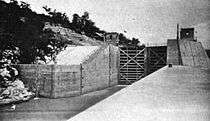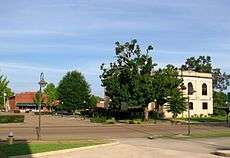Marion County, Tennessee
Coordinates: 35°08′N 85°37′W / 35.13°N 85.61°W
| Marion County, Tennessee | |
|---|---|
 Marion County Courthouse in Jasper | |
|
Location in the U.S. state of Tennessee | |
 Tennessee's location in the U.S. | |
| Founded | 1817 |
| Named for | Francis Marion[1] |
| Seat | Jasper |
| Largest town | Jasper |
| Area | |
| • Total | 512 sq mi (1,326 km2) |
| • Land | 498 sq mi (1,290 km2) |
| • Water | 14 sq mi (36 km2), 2.8% |
| Population | |
| • (2010) | 28,237 |
| • Density | 57/sq mi (22/km²) |
| Congressional district | 4th |
| Time zone | Central: UTC-6/-5 |
| Website |
www |
Marion County is a county located in the U.S. state of Tennessee. As of the 2010 census, the population was 28,237.[2] Its county seat is Jasper.[3]
Marion County is part of the Chattanooga, TN–GA Metropolitan Statistical Area.
History
Marion County was established in 1817 from lands acquired from the Cherokee.[4]
In 1779 Cherokee chief Dragging Canoe moved down the Tennessee River from Chickamauga Creek to Running Water creek, and helped establish the associated town of Nickajack in front of the entrance to Nickajack Cave. In 1794, this town was attacked and burned. This attack was led by Colonel James Orr of Nashville, Tennessee. The town was rebuilt and the Chickamauga Band of Indians continued to live here until 1838, when all remaining Indians were removed from Tennessee, Alabama, and Georgia via the Trail of Tears.[5]

In the Spring of 1861, Robert Cravens of Chattanooga began mining saltpeter, the main ingredient of gunpowder, at Nickajack Cave. This operation was eventually taken over by the Confederate Niter Bureau. At one point, Nickajack Cave was one of the main sources of saltpeter for the Confederate States of America. Nickajack Cave was visited by thousands of Civil War troops, who moved up and down the Tennessee River on boats.[5]
Another important saltpeter mine during the Civil War was Monteagle Saltpeter Cave, located in Cave Cove, approximately 4 miles (6.4 km) southeast of Monteagle. During the Civil War, it was referred to as Battle Creek Cave. A 1917 visitor to the cave reported 25 or 30 old hoppers remaining in the cave.[6]
In the late 19th and early 20th centuries, coal and iron ore mining industries dominated the county's economy. Mines operated in Whitwell and Inman, and smelters operated in South Pittsburg.[4]
Hales Bar Dam, built along the Tennessee River in Marion County between 1905 and 1913, was one of the nation's first major dams constructed across a navigable channel. The Tennessee Valley Authority replaced Hales Bar with Nickajack Dam further downstream in the 1960s, though the Hales Bar powerhouse (now a boathouse) still stands.[4]
Geography

According to the U.S. Census Bureau, the county has a total area of 512 square miles (1,330 km2), of which 498 square miles (1,290 km2) is land and 14 square miles (36 km2) (2.8%) is water.[7] Marion is one of three Tennessee counties, along with Bledsoe and Sequatchie, located in the Sequatchie Valley, a long, narrow valley slicing through the southeastern Cumberland Plateau. The Sequatchie River, which drains the valley, empties into the Tennessee River just south of Jasper.
Nickajack Dam is located along the Tennessee River near Jasper, creating Nickajack Lake. The section of the river immediately downstream from the dam is part of Guntersville Lake. The Raccoon Mountain Pumped-Storage Plant is located in the extreme southeastern part of the county.
Adjacent counties
- Grundy County (north)
- Sequatchie County (northeast)
- Hamilton County (east)
- Dade County, Georgia (southeast)
- Jackson County, Alabama (southwest)
- Franklin County (west)
State protected areas
- Chimneys State Natural Area
- Cummings Cove Wildlife Management Area
- Franklin State Forest (part)
- Hicks Gap State Natural Area
- Prentice Cooper State Forest
- Sequatchie Cave State Natural Area
- South Cumberland State Park (part)
Demographics
| Historical population | |||
|---|---|---|---|
| Census | Pop. | %± | |
| 1820 | 3,888 | — | |
| 1830 | 5,508 | 41.7% | |
| 1840 | 6,070 | 10.2% | |
| 1850 | 6,314 | 4.0% | |
| 1860 | 6,190 | −2.0% | |
| 1870 | 6,841 | 10.5% | |
| 1880 | 10,910 | 59.5% | |
| 1890 | 15,411 | 41.3% | |
| 1900 | 17,281 | 12.1% | |
| 1910 | 18,820 | 8.9% | |
| 1920 | 17,402 | −7.5% | |
| 1930 | 17,549 | 0.8% | |
| 1940 | 19,140 | 9.1% | |
| 1950 | 20,520 | 7.2% | |
| 1960 | 21,036 | 2.5% | |
| 1970 | 20,577 | −2.2% | |
| 1980 | 24,416 | 18.7% | |
| 1990 | 24,860 | 1.8% | |
| 2000 | 27,776 | 11.7% | |
| 2010 | 28,237 | 1.7% | |
| Est. 2015 | 28,487 | [8] | 0.9% |
| U.S. Decennial Census[9] 1790-1960[10] 1900-1990[11] 1990-2000[12] 2010-2014[2] | |||

As of the census[14] of 2010, there were 28,237 people, 11,403 households, and 8,030 families residing in the county. The population density was 57 people per square mile (22/km²). There were 12,954 housing units at an average density of 26 per square mile (10/km²).
The racial makeup of the county was 93.9% White(non-Hispanic), 3.6% Black or African American, 0.4% Native American, 0.21% Asian, 0.01% Pacific Islander, 0.27% from other races, and 1.2% from two or more races. 1.3% of the population were Hispanic or Latino of any race.
In the county, the population was spread out with 22.80% under the age of 18 and 8.9% who were 65 years of age or older. The median age was 43.9 years. The female population was 50.9%.
The median income for a household in the county was $31,419, and the median income for a family was $36,351. Males had a median income of $30,236 versus $21,778 for females. The per capita income for the county was $16,419. About 10.80% of families and 14.10% of the population were below the poverty line, including 20.00% of those under age 18 and 14.30% of those age 65 or over.
Education
The schools in Marion County are:
- Jasper Elementary School
- Jasper Middle School
- Marion county High School
- Monteagle Elementary School
- South Pittsburg Elementary
- South Pittsburg High School
- Whitwell Elementary School
- Whitwell Middle School
- Whitwell High School
Media
Marion County is served by numerous local, regional and national media outlets which reach approximately one million people in four states including: Tennessee, Alabama, Georgia and North Carolina.
Newspapers
- The Jasper Journal is a weekly news publication that covers news from in and around the county including a community calendar. The Journal features stories from around the county and features such as the "Whitwell Progress" which covers happenings specific to Whitwell. The Jasper Journal is published by Marion County Newspapers, Inc., located in South Pittsburg.
- The South Pittsburg Hustler is also a weekly news publication published by Marion County Newspapers, Inc. The Hustler, as it is commonly called by local residents, covers stories from around Marion County, but is more specific to South Pittsburg.
Radio
Marion County is part of the Chattanooga Arbitron radio market. The following radio stations are licensed to cities within Marion County:
- AM
- WEPG 910 AM – News Talk & Variety Hits (Licensed to South Pittsburg)
- WTNW 820 AM – Oldies/Classic Hits (Licensed to Jasper)
- FM
- WUUQ 97.3 – Classic Country Q-97.3/99.3 (Licensed to South Pittsburg)
- WJCR-LP-94.9 - Jasper Christ-Centered Radio (Licensed to Jasper)
Television
Marion County is part of the Chattanooga DMA. Cable TV companies in Marion County include Charter Communications and Trinity Cable
Transportation
Airport
Marion County Airport, also known as Brown Field, is a county-owned, public-use airport located four nautical miles (7 km) southeast of the central business district of Jasper.[15]
Parks and natural features
Nickajack Cave in Marion County, located 0.6 miles south of Shellmound Station on the west side of the Tennessee River, is one of the most historical caves in Tennessee.[16] It is currently part of a park run by the city of New Hope. A paved hiking trail leads to an observation deck at the entrance to the cave where visitors can watch the bats leave the cave at dusk.[17] The cave was used by tourists and as a show cave, but in 1968 the cave was flooded when Tennessee Valley Authority constructed Nickajack Dam 6 miles (9.7 km) downstream to replace the aging Hales Bar Dam.
Communities

Cities
Towns
Unincorporated communities
- Griffith Creek
- Haletown
- Mineral Springs
- Sequatchie
- Whiteside (formerly Running Water)
Notable people
- Artist Jon Coffelt (b. May 16, 1963) was born in Dunlap, Tennessee, raised in Griffith Creek and now lives and works in New York City.
- Dragging Canoe, Cherokee leader, lived in the town of Running Water at the mouth of Running Water creek on the Tennessee River.
- Judge John T. Raulston, who presided over the Scopes Trial in 1925.
- Sequoyah, Cherokee scholar, lived in the Marion County area. Sequoyah is famous for developing a Cherokee alphabet, making the Cherokee Nation literate in their own language. A bust honoring Sequoyah is in the town of South Pittsburgh in front of the Beene Pearson Public Library.
- Peter Turney, Governor of Tennessee and Chief Justice of the Tennessee Supreme Court, was born in Jasper.
- Eric Westmoreland, NFL player
See also
References
- ↑ Patsy Beene, "Marion County," Tennessee Encyclopedia of History and Culture. Retrieved: 11 March 2013.
- 1 2 "State & County QuickFacts". United States Census Bureau. Retrieved December 6, 2013.
- ↑ "Find a County". National Association of Counties. Retrieved 2011-06-07.
- 1 2 3 William Ray Turner, "Grundy County," Tennessee Encyclopedia of History and Culture. Retrieved: 16 October 2013.
- 1 2 "Caves of Chattanooga" by Larry E. Matthews, 2007, Published by the National Speleological Society, ISBN 978-1-879961-27-2
- ↑ Marion O. Smith, Confederate Niter District Eight: Middle Tennessee & Northwest Georgia, 2011.
- ↑ "2010 Census Gazetteer Files". United States Census Bureau. August 22, 2012. Retrieved April 9, 2015.
- ↑ "County Totals Dataset: Population, Population Change and Estimated Components of Population Change: April 1, 2010 to July 1, 2015". Retrieved July 2, 2016.
- ↑ "U.S. Decennial Census". United States Census Bureau. Retrieved April 9, 2015.
- ↑ "Historical Census Browser". University of Virginia Library. Retrieved April 9, 2015.
- ↑ Forstall, Richard L., ed. (March 27, 1995). "Population of Counties by Decennial Census: 1900 to 1990". United States Census Bureau. Retrieved April 9, 2015.
- ↑ "Census 2000 PHC-T-4. Ranking Tables for Counties: 1990 and 2000" (PDF). United States Census Bureau. April 2, 2001. Retrieved April 9, 2015.
- ↑ Based on 2000 census data
- ↑ "American FactFinder". United States Census Bureau. Retrieved 2011-05-14.
- ↑ FAA Airport Master Record for APT (Form 5010 PDF). Federal Aviation Administration. Effective 11 February 2010.
- ↑ Barr, Thomas C., Jr. (1961). Caves of Tennessee.
- ↑ Matthews, Larry E. (2007). Caves of Chattanooga. National Speleological Society. ISBN 978-1-879961-27-2.
External links
| Wikimedia Commons has media related to Marion County, Tennessee. |
- Marion County Chamber of Commerce
- Marion County Schools
- Marion County, TNGenWeb - free genealogy resources for the county
- Marion County at DMOZ
 |
Grundy County | Sequatchie County |  | |
| Franklin County | |
Hamilton County | ||
| ||||
| | ||||
| Jackson County, Alabama | Dade County, Georgia |

